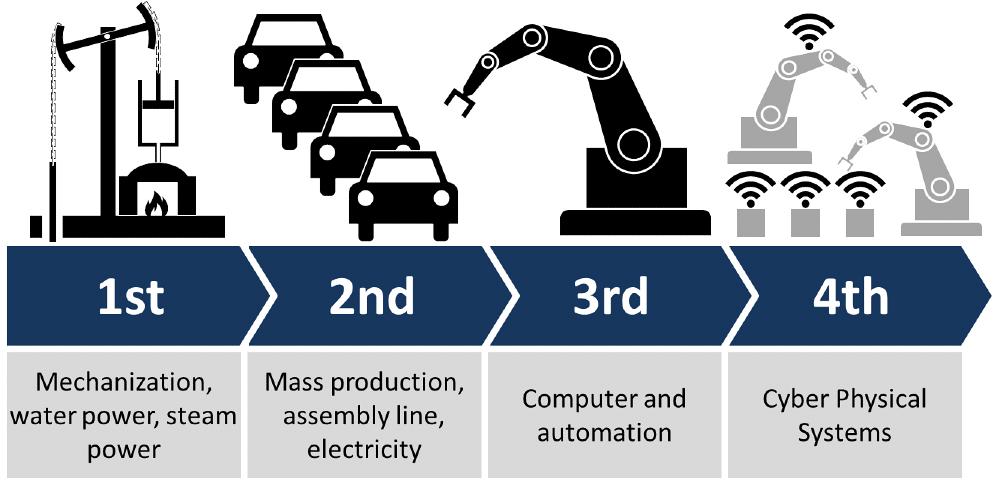Editor-in-Chief
- FMA
- The Fabricator
- FABTECH
- Canadian Metalworking
Our Publications
Categories
- Additive Manufacturing
- Aluminum Welding
- Arc Welding
- Assembly and Joining
- Automation and Robotics
- Bending and Forming
- Consumables
- Cutting and Weld Prep
- Electric Vehicles
- En Español
- Finishing
- Hydroforming
- Laser Cutting
- Laser Welding
- Machining
- Manufacturing Software
- Materials Handling
- Metals/Materials
- Oxyfuel Cutting
- Plasma Cutting
- Power Tools
- Punching and Other Holemaking
- Roll Forming
- Safety
- Sawing
- Shearing
- Shop Management
- Testing and Measuring
- Tube and Pipe Fabrication
- Tube and Pipe Production
- Waterjet Cutting
Industry Directory
Webcasts
Podcasts
FAB 40
Advertise
Subscribe
Account Login
Search
Industry 4.0: misunderstood revolution
Though everyone has heard of Industry 4.0, few completely understand it
- By Don Nelson
- November 16, 2021
Industry 4.0 is like Bitcoin to those in manufacturing. They have heard and talked about it, and most feel like they will be left behind if they don’t invest in it. At the same time, few are sure what Industry 4.0 is, why they need it, or even how to define it.
The best definition I’ve found comes from futurist Bernard Marr. He describes Industry 4.0—the Fourth Industrial Revolution—as a transformation of the way we produce products, thanks to the digitization of manufacturing. The first revolution was mechanization through water and steam power. The second was mass production and assembly that harnessed electricity. The third was the use of computers and automation. Industry 4.0 takes the computers and automation of Industry 3.0 and enhances them with smart and autonomous systems fueled by data and machine learning.
You’ll find two pieces about Industry 4.0 in this issue of The Additive Report.
The first is “Digital Dealmaker”, an article that looks at how additive manufacturing is sabotaging its own acceptance as a key Industry 4.0 technology because of postprocessing.
Two of the three main AM process steps—design and 3D printing—conform well with the digitization thrust of Industry 4.0. DfAM (design for additive manufacturing) and printing are paperless, contactless operations that, once set in motion, require little or no human intervention.
Step three, postprocessing, puts the brakes on AM process workflows. Most postprocessing operations involve manual tasks such as grinding, milling, or cutting away support structures and other extraneous materials.
Failure to automate postprocessing will prevent AM’s use in the digitized manufacturing facilities of the future.
The other Industry 4.0 piece in this issue is a column titled “Whaaaat?! Industry 5.0?”. Additive Report contributor Kip Hanson shares his thoughts about the effort to move from Industry 4.0 into Industry 5.0.
“Really?” he asks. “We don’t have a good start on Industry 4.0 and now you want to throw even more technical stuff at manufacturers? We’ve barely scratched the surface of the Fourth Industrial Revolution.”
What prompted Hanson to write the column is a paper titled “The Curious Case of Industry 5.0.” The author, Katerina Yordanova, is an attorney in Belgium who specializes in human-rights laws in the digital age.
She explains that Industry 5.0 comprises three interconnected blocks: “The first block is a human-centric approach to industry, which puts human needs at the heart of production … rather than insisting people adapt to technologies. The second block, sustainability, relates to the need for development of circular processes that allow for the re-use, repurposing, and recycling of natural resources. ... The third block is resilience, which is … the need for development of a higher level of robustness of both production and supply chains.”
At the top of this column, I wrote that Industry 4.0 is much discussed but little understood. It’s also debatable how much Industry 4.0 is actually used by those in the manufacturing trenches.
One can make a credible argument that Industry 4.0 technologies aren’t used much by companies that actually produce goods. Why? Because the overwhelming majority of them are too busy trying to get product out the door to devote time and money to developing a digital strategy and digitizing their plants.
I’d argue that the overwhelming majority of manufacturers have adopted some Industry 4.0 concepts and technologies, such as computer-governed machines, design and process software, sensing and monitoring devices, cloud computing, lights-out capabilities, and automation.
What they haven’t adopted is a catchy, overarching phrase that sums up these concepts and technologies—like Industry 4.0.
(Image: Christof Roser, All About Lean)
About the Author

Don Nelson
2135 Point Blvd.
Elgin, IL 60123
(815)-227-8248
About the Publication
- Podcasting
- Podcast:
- The Fabricator Podcast
- Published:
- 04/16/2024
- Running Time:
- 63:29
In this episode of The Fabricator Podcast, Caleb Chamberlain, co-founder and CEO of OSH Cut, discusses his company’s...
- Trending Articles
- Industry Events
16th Annual Safety Conference
- April 30 - May 1, 2024
- Elgin,
Pipe and Tube Conference
- May 21 - 22, 2024
- Omaha, NE
World-Class Roll Forming Workshop
- June 5 - 6, 2024
- Louisville, KY
Advanced Laser Application Workshop
- June 25 - 27, 2024
- Novi, MI



























